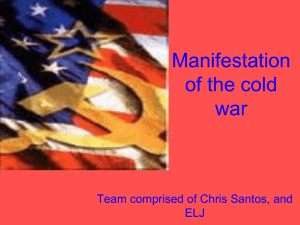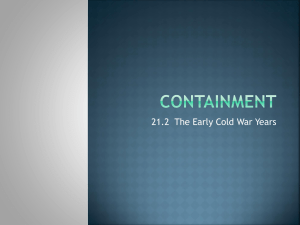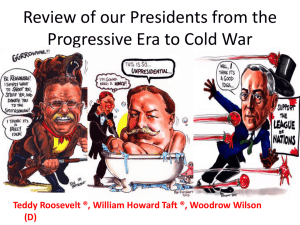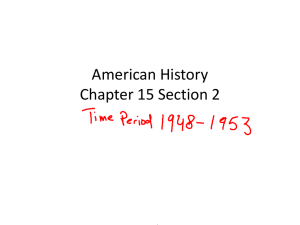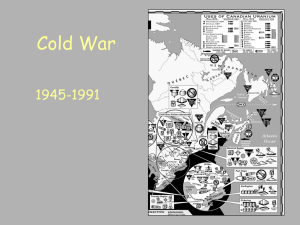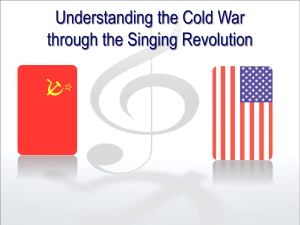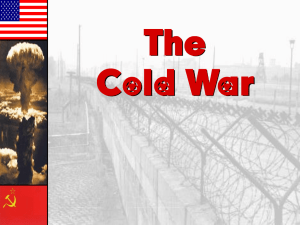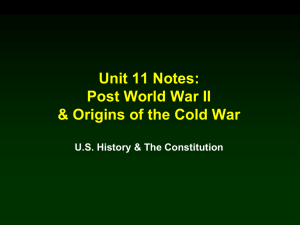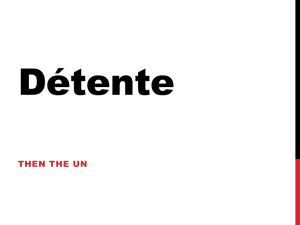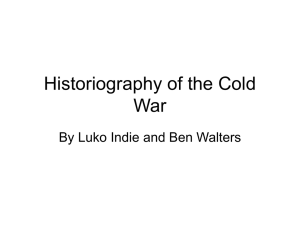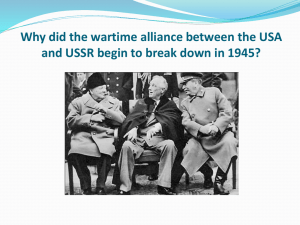Cloze Notes on PowerPoint - Kierstead`s St. Andrew`s Web Page
advertisement
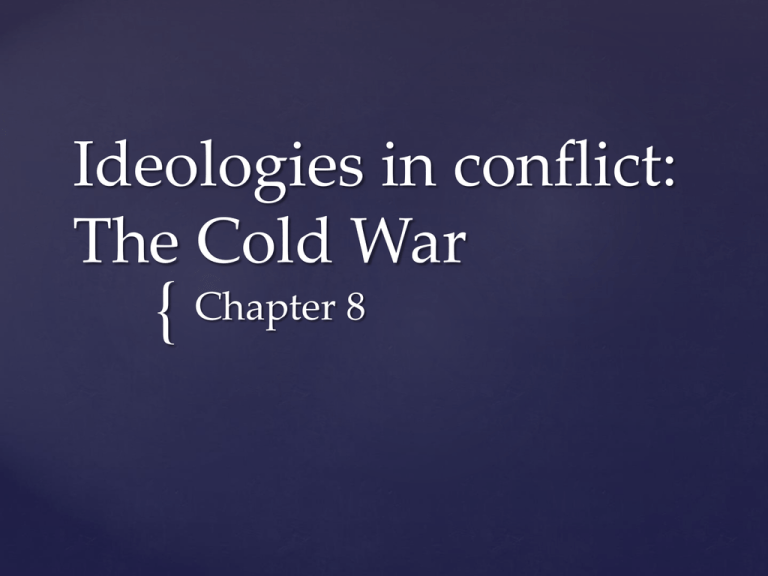
Ideologies in conflict:
The Cold War
{ Chapter 8
Students will examine how ideological
conflict shaped international relations
after the Second World War
(expansionism, containment, deterrence,
brinkmanship, détente, liberation
movements)
Specific Outcome 2.10
To what extent can ideological
conflict influence international
relations?
At times ideologies can be strict and
unbending. At other times they can be more
flexible and adjustable.
An ideology can change, adapt and even
contradict itself just like people can.
Classical liberalism was put to the test in 18th
and 19th century Britain. As a result there were
calls to address the inadequacies of this
ideology especially economic concerns.
Ideologies Recap
During WWII, the USSR and the United States
put their differences aside to fight a common
enemy: Nazi Germany.
When the war ended they returned to their
ideological conflict: Capitalist liberal
democracy vs. Communism.
Both countries went to amazing lengths to
protect and promote their ideologies.
Ideological Conflicts &
The Cold War
Unlikely Alliance
In 1927, Joseph Stalin predicted the following:
“…there will emerge two centers of world
significane: a socialist center, drawing to itself the
countries that incline towards socialism, and a
capitalist center, drawing to itself the countries thay
incline towards capitalism. Battle between these two
centers for command of the world economy will decide
the fate of capitalism and of communism in the entire
world.”
Competing ideologies
At the end of WWII, the USSR, USA and Britain
had already decided what would happen to the
territory that Germany had occupied during
the Second World War.
How can competing
ideologies create tension
in international relations?
In 1945, WWII was in its last stage, and it was
clear that the Allied powers would defeat Nazi
Germany.
Both the USA and the USSR had gained power
and had strong economies. Thus they became
known as the two “superpowers”
When the big three met at the Yalta conference
in southern Ukraine they planned to “redraw”
the map of Europe.
Yalta Conference
Yalta 1945
Dividing Germany into 4 zones of occupation
(British, America, French and Russian)
Having free elections in the newly liberated
countries of Europe, in keeping with “the right
of all people to choose the form of government
under which they live.”
Agreements at Yalta
Unconditional surrender of Germany was formally
signed on May 8th, 1945. Countries throughout
Europe now faced the uncertain future because their
political, economic and social systems were in chaos.
Big three met again in Potsdam, but had experienced
changes at home. Clement Atlee had replaced
Winston Churchill, and Franklin Delano Roosevelt
had passed and Harry S. Truman had taken his
position as President of the United States of America
Both were avidly anti-communist
Germany Surrenders!
Many Historians agree that
Potsdam was the beginning of the
Cold War.
Walter LeFaber notes “Potsdam marks
the point at which Truman and Stalin
don’t have a whole lot to say to each
other anymore. Their armies are
essentially doing the talking.”
Potsdam
The division of
Germany and Austria
into four zones of
occupation
Allowance that free
elections would take
place in Poland
Agreements at Potsdam
An agreement that said
the USSR would join the
war in Japan
Potsdam
Germany will pay 20
Billion Dollars in
Reparations to the Allies
Restructuring of
German economy
towards agriculture
and light industry.
Limiting military
production
Yalta’s optimism was short lived.
USSR and USA at the end of WWII began to
establish “Spheres of Influence” – Countries they
would influence politically.
Countries liberated by the US were in the USA’s
Sphere and Countries liberated by the Soviets were
in the soviet sphere of influence.
Stalin saw postwar expansionism as a way to get
“command of the world economy” and justified it
for 2 reasons
Keep Germany divided.
Buffer zone for safety
Expansionism
Expansionism
Harry S. Truman said “nearly every nation must choose
between alternative ways of life.”
In post war Europe and around the world –countries were
making exactly the choices that Truman described. They did
not want another hot war”
The Truman Doctrine:
FP to support anti-communist forces in Greece and Turkey
through a $400 – million dollar economic and military package
Marshall Plan:
Extended the Truman doctrine and announced a $13 – Billion
dollar plan to help devastated European countries.
Offered to all countries
Truman believed that if countries became prosperous again then
they would be less likely to support capitalism
Containment
{
National Center for
policy Analysis
Recipients had to agree to
balance their budgets,
stop inflation and
stabilize their exchange
rates at realistic levels.
They were encouraged to
decontrol prices,
eliminated trade
restrictions and resist
nationalization. (Free
Market Economy)
Marshall plan
{
Foreign Minister
Vyacheslav Molotov
“Churchill’s words
won the war and
Marshall’s words
won the peace.”
{
NATO
North Atlantic Treaty
Organization
Hungary and
Czechoslovakia were under
Soviet control, Greece and
Turkey were not. Britain,
France, Belgium,
Luxembourg and the
Netherlands signed the
Brussels Treaty on March
17th, 1948 so that member
countries would help one
another if they were
invaded by Soviet Russia
The US joined and the name
became NATO – collective
security
{
Warsaw Pact
Soviet Response
Once West Germany
joined NATO it was
in direct threat to
the Eastern Bloc
(Soviet Sphere of
Influence)
NATO & Warsaw
1.
2.
3.
What 2 specific issues does Stalin address? How
does he defend the actions of the Soviet Union?
What is the main issue that Truman could be
referring to when he talks about the armed
minority imposing itself on the majority?
What obstacles to understanding and agreement
do you see between the two sides?
Expansionism pg. 192
Winston Churchill in a Speech at West Virginia
College in 1946 described the expansionism of
communist influence as an “Iron Curtain”
Commonwealth countries and the USA would
have to be a strong military and moral force
against the firebrand of war.
Escalating Tensions
Espionage
Balance of
Power
Proxy Wars
Brinkmanship
Arms Race
Cold War
Strategies
Deterrance
Propaganda
Space Race
Prestige Race
Defense
Systems
Propaganda
Sometimes the cold war was a battle between
governments which politicians treated each other
with great disrespect, including engaging in
actions like threatening another or name-calling.
Governments mainly used propaganda to
promote their ideologies
Both methods were key aspects in understanding
how tensions increased.
War of Words
Also known as wars of achievements rather
than direct battle.
A government might believe and present the
achievement of being the first the best or the
winner in a non-military competition as proof
that it ideology is better than its opponents.
Prestige War
Knowledge is power, in the case of the governments
locked up in an ideological conflict, feel the need to
know as much as possible about their enemies. In
1962, for example the US play plane played a key
role in the Cuban missile Crisis.
James Bond M16
Igor Gouzenko – fled the Canadian Soviet Embassy
in Ottawa with 109 documents that proved the
existence of a Soviet Spy ring in Canada.
China and the Hainan Island Incident 2001
Espionage
With the development of Nuclear weapons, the
USSR and the USA knew that a “hot war”
would not only destroy both nations but also
the entire world. (Dr. Strangelove & K19)
Deterrence was defined as the belief that when
both superpowers possess enough nuclear
weapons to destroy each other they will be
deterred from starting a war because nuclear
war was not desirable or winnable.
Mutually Assured Destruction
Figure 8-13 of your textbook
Deterrence
Pushing a dangerous conflict to the tipping
point where it is about to end in disaster.
Dangerous game of Chicken
Brinkmanship
Raymond Garthoff, an intelligence analyst in the State Department,
wrote the following on October 29th, 1962
“If we have learned anything from this experience, it is that weakness, even
only apparent weakness, invited Soviet Transgression. At the same time,
firmness in the last analysis will force the Soviets to back away from rash
and impulsive initiatives.”
What was the danger of not using the strategy of brinkmanship when
dealing with the Soviet Union?
How does the Cuban missile Crisis illustrate the extent to which
ideological conflict influences international relations. How it can
escalated tensions and how certain actions can fuel conflict?
In the Sources provided in Voices on page 201 of your text, find
examples of phrases, sentences, or strategies that could have increased
tensions and that could have decreased tensions between the two
superpowers during the CMC.
What conflicts and barriers to understanding existed between the US
and the USSR and Cuba? How were they overcome?
Cuban Missile Crisis pg. 201
The cold war was not always cold. It often led
to full out hot wars played out on foreign soil.
A proxy war is a war that results when two
countries use third parties or countries as
alternatives to fighting directly with one
another.
Being America’s neighbour and sharing much
of the same ideologies usually meant that
Canada fell under the US sphere of influence.
However, this was not always the case.
Proxy Wars
At the end of WWII, Japan occupied Korea. In August of
1945, Soviet troops attacked Northern Korea and
advanced to the 38th parallel.
The US and the USSR agreed to split Korea in 2. Both
countries left the region by 1949.
Kim Il-sung felt it was necessary to reunite Korea and
planed to attack the south.
The USSR supplied North Korea with Weapons and by
April 1950 Stalin had given his approval.
The US became involved and 15 other UN countries sent
troops.
In October the Soviets were pushed back but it wasn’t
enough just to contain communism in Korea, they
wanted to rid Korea of communism. War went on for 3
more years and a ceasefire was signed on July 27th, 1953.
Korean War
French had ruled Indochina in the 1800’s.
France regained control after the Japanese were
defeated in WWII.
Ho Chi Minh was extremely popular in Vietnam. He
was a communist who also fought against colonialism.
1954 defeats the French and Dein Bien Phu Fell.
Vietnam was divided at the 17th Parallel
US sent weapons and advisors and by 1966 there were
500,000 US troops in Vietnam.
1973 because of a stalemate in talks, anti-war protests,
the failing draft and high casualties The US lost Saigon
and South Vietnam became a communist state.
Vietnam
Soviets wanted to gain friendly neighbour by
supporting a pro-soviet regime in Afghanistan, “the
Marxist People’s Democratic party of Afghanistan”
against the Mujahedeen (Muslims involved in Jihad)
US equip Mujahedeen while soviets supported their
own troops however it was difficult because:
Other Islamic countries and the US supplying
troops and weapons
There was often more support for specific clan or
group than for the government.
Lack of support from rural populations
Soviets in Afghanistan
Reducing
International
Tensions
Diplomacy
Liberation Movements
In what ways can
international tensions be
reduced?
Détente
and
Treaties
End of the cold war
Canada has a long record of helping countries
to find peaceful resolutions to their conflicts.
Lester B. Pearson helped negotiate peace for
Korea in 1957
Bandung conference 1955 – promote African
and Asian economic and cultural cooperation
(avoid imperialistic countries US and GB)
Non-Alignment – many countries chose not to
side with the US or the USSR. This included
China under Communism.
Diplomacy
Relations between the US and communist china
were described as ‘chilly’ between 1949 and
1970.
The US used unique ways to build relations
like Ping-pong (Forrest Gump)
“Friend-ship Matches”
This was so successful that Richard Nixon was
allowed to visit china in 1972 and set up a
framework for relations.
Ping-Pong Diplomacy
Hungarian Revolution 1956
Students demonstrated in the capital, Budapest,
state police shot at students and the movement
spread.
A New government was formed and declared its
intention to pull out of the Warsaw Pact.
Soviets then invaded Hungary and took over
once again with high death tolls and thousands
of out-migration.
Liberation Movements
1968 – A period of political liberation in
Czechoslovakia that started when government
reformists came into power in January 1968.
Alexander Dubcek reforms included loosening
restrictions on media, additional rights for
citizens, partial decentralization of the
economy, free speech and travel
Liberation movement was halted and Soviets
invaded and held control until 1990
Prague Spring
Polish shipyard worker who started the first,
anti-communist, Labour Union in Poland.
Started a stream of anti-communist protests
and finally ended Soviet control of Poland in
October of 1989.
Lech Walesa became the first president of a
Soviet-Free Poland since 1939.
Lech Walesa-Polish Solidarity
In 1961 the East-German wall was built to keep East
Germans from Escaping to the West. The Wall was a
political, economic and cultural iron curtain.
People who tried to escape were shot.
President John F. Kennedy
“Two thousand years ago the proudest boast was
civis romanus sum [I am a Roman Citizen]. Today, in
the world of freedom, the proundest boast is “Ich
Bin Ein Berliner”… All free men, wherever they
may live are citizens of Berlin and, therefore, as a
freeman I take pride in the words “Ich bin ein
Berliner”
In 1989 a series of liberation movements spread
across Europe and the Berlin wall was open in 1991
signifying the end of the Cold War.
Berlin Wall

